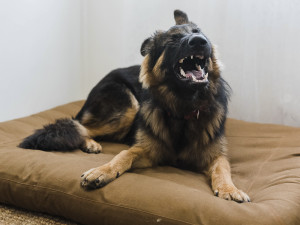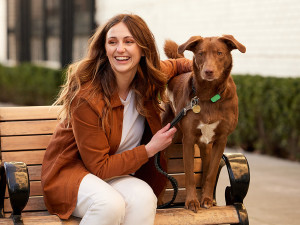Immunotherapy Can Be the Solve For Your Dog’s Allergies
If allergens were to ask, “Am I the drama?,” the answer would be yes.
Dogs: They’re just like us! They need love and activity to thrive, they poop better in a squatting position, and sometimes they hump someone they shouldn’t. Also, much like us, they can have allergies.
My own dog, Cleo, is allergic to cedar pollen, a discovery we made during our second winter in Austin, Texas, when she started itching urgently and constantly, day and night. The vet gave her a shot of Cytopoint, a drug which blocks the signals that trigger a dog’s allergic itch. It worked, and fortunately for us, the peak of Austin’s cedar hell is only about three months.
Snap a pic of your pup’s teeth, and GREENIES™ will help you spot potential signs of oral health issues.
For some dogs and their owners, though, allergies are an all-year struggle. In these cases, repeated itch-relief shots can be expensive and ineffective. But there is a possible solution: allergy immunotherapy, a treatment which introduces allergens into the dog’s body via injections or drops under the tongue so that your pup can build up a resistance to them.
“Allergy immunotherapy is the only thing that potentially could stop the allergies from getting worse but also directly addresses the causes [of allergies],” says Dr. Britt Levy, of the Pet Dermatology Center in Philadelphiaopens in new tab. Below, everything you need to know about the treatment.
How much do you spend on your pet per year?
What are dogs allergic to in the first place?
Dogs can be allergic to a lot of the same environmental allergens that we are. At the top of the list: trees in the spring, grasses in the summer, weeds in the winter or fall, and dust mites year-round. Note: Food allergies are generally treated differently than environmental allergies, so for the purpose of this story, Kinship focused on environmental allergens.
One major difference between dog and human allergies, though, is that dog allergies tend to worsen as they get older. So if an itch relief-shot works for a dog when they’re younger, it might not work as well for them when they’re older.
How can you tell if your dog has allergies?
“When people throw around the term ‘allergies,’ most of the time what we’re talking about is artopic dermatitis,” explains Dr. Levy. “In people, they call it eczema.”
Essentially, if they’re having an allergic reaction to something, dogs will usually get very itchy in specific places, such as their feet, their armpits, or their groin. Indeed, when cedar season came to Austin, Cleo went at her toes like there were tiny rib-eye steaks hidden between them, only pausing long enough to sit up and itch at the skin under her arms.
Ear infections are also a common symptom of allergies, though it’s a lesser-known symptom that often gets misdiagnosed — and therefore mismanaged.
“If you have a dog that’s getting recurrent ear infections, 99 percent of the time it’s due to underlying atopic dermatitis,” Dr. Levy says. For roughly 10 percent of allergic dogs, Dr. Levy estimates, ear infections are the only clinical symptom they will have. “So they just keep going to the vet and getting drops or ear washes, but it’s never going to go away because you’re not managing the underlying cause.”
Is your dog a good candidate for immunotherapy?
Generally, Dr. Levy says that a good client for immunotherapy would be a dog who exhibits obvious clinical symptoms for at least six months of the year. Most dogs are good candidates, she adds, and it’s not at all harmful to treat a dog who only has symptoms for part of the year. Maybe the better question is this: Is the owner a good candidate for immunotherapy, are they willing to take on the associated costs, and ready to make the effort to manage the treatment effectively?
“It’s more of a matter of is this something the owner is willing to do long-term,” Dr. Levy says.
How long-term? Experts say you need at least a year to determine how effective the treatment will be for your pet. And if it is effective, most canine patients will need it for the rest of their lives. On the bright side, unlike some medical treatments, it’s all natural, so you don’t need to worry about how the medication will affect your dog over time. “It’s not a drug,” Dr. Levy emphasizes. “It’s just little pieces of pollen.”
OK, so how does immunotherapy for dogs work?
So you’ve determined your dog has allergies, now what? The first step of immunotherapy is to determine which allergies, exactly, they have. This can be done through a skin prick test, or a blood test, both of which have equally good results. For brachycephalic dogs, such as bulldogs, however, Dr. Levy recommends doing prick tests under general anesthesia, or while intubated. If these dogs have an allergic reaction, their already fragile airways could become swollen and prevent them from breathing.
With both skin prick tests and blood tests, timing is important. Dr. Levy recommends doing testing after the dog has been showing clinical symptoms for at least a year. “It’s expensive, and you wanna get your bang for your buck, so ideally you have a year to be exposed to different pollens, to see what the different patterns are.” She also recommends doing testing at the end of the dog’s most severe allergy season — ideally when they’re still a little bit symptomatic. This way, the tests can pick up the higher antibody levels.
Once you’ve ascertained what’s in your dog’s unique cocktail of allergies — say, crabgrass and dust mites — the dermatologist will mix those allergens in a vial that you can then administer to your dog either with injections every few days (how often depends on your dog’s course of treatment, but often every three days, lengthened eventually to every seven days) or drops under their tongue twice a day.
How successful is immunotherapy for dog allergies?
“We say to most people that 60 to 70 percent of dogs get 60 to 70 percent better,” Dr. Levy says. She also estimated that 90 percent of patients will see some degree of improvement. While studies have shown that 10 percent of patients might see no results whatsoever, Dr. Levy says she’s personally never seen that happen.
How much does immunotherapy for dog allergies cost?
Most of your costs will be upfront, for testing; skin prick tests and blood tests cost a couple of hundred dollars. And while price varies from region to region and practice to practice, Dr. Levy says that a couple of vials of injections will usually set you back around $350 or $400. Although that’s not cheap, when you consider that there are multiple shots per vial, the cost per month ends up being around $65 — significantly cheaper than a monthly anti-itch shot, which can cost about $150.
Allergy immunotherapy is an amazing option for dogs who have allergies all year. But if they only get a little itchy for a few weeks in the spring, an anti-itch shot might be the cheaper, easier option. Or, you could always turn your whole life upside down and move somewhere far away from the villainous allergens. Cleo and I recently moved back to my hometown of Washington, D.C. So far, she has been blissfully itch-free.











